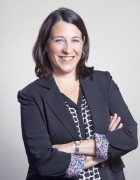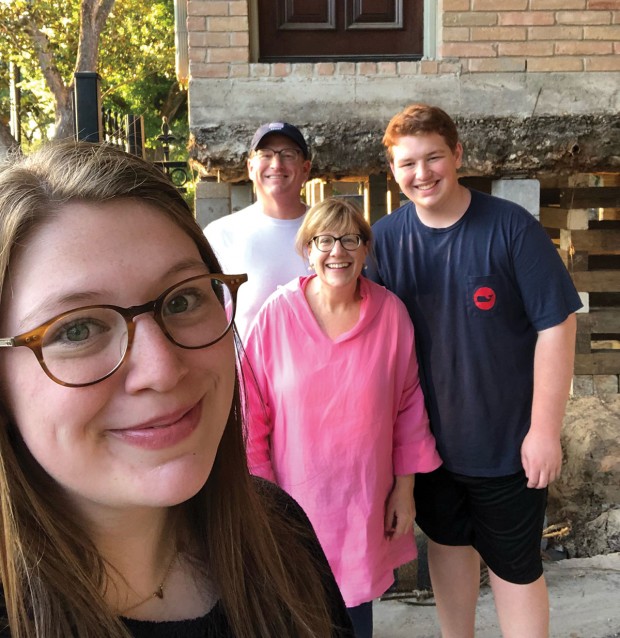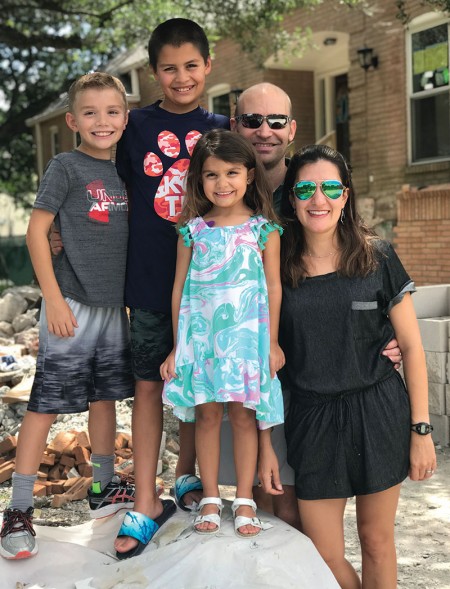Saving Meyerland
Residents rise to the challenge

Meandering the streets of Meyerland, it doesn’t take long to notice the bareness that still dots the tree-lined streets here. Shells of homes litter the landscape after floodwaters from Hurricane Harvey ravaged the area one year ago, ejecting families from their homes and tight-knit community.
“My husband grew up in this neighborhood; he went to Kolter Elementary. I grew up just five minutes down the road. This neighborhood has always been ‘home’ for us. You can't beat the location, the bayou trails are wonderful, the homes have character with beautiful trees,” said Valerie Davis, mother of 10-year-old Luke, 8-year-old Eli and 4-year-old Jules.
According to one estimate, 1,900 of the 2,400 homes that make up Meyerland had water in them. For residents like the Davis family, flooding has become a too-familiar story, after Memorial Day 2015, Tax Day 2016 and, finally, Hurricane Harvey 2017. But roots run deep in Meyerland, and many families, including the Davises, are staying.
“We knew this time we couldn't take the risk of repairing and moving back in at ground level. We cleaned and dried out our home as quickly as we could,” said Valerie. “We took a few months to consider our options: sell our home, tear down our home, or elevate our home. The thought of moving to a non-flooding neighborhood was very enticing; however, when we thought about what brought us to Meyerland in the first place, there was no way we could leave.”
Once showcased in magazines for its affordable single-story ranch-style homes and its "ideal plan" for a subdivision, Meyerland is the vision of a man named George Meyer who in 1955 developed 1,200 acres of rice fields into the neighborhood. What was first built as a suburb is now a community that hugs the heart of Houston, touted for its convenient commute to the Medical Center, the Galleria and downtown. It is a quiet enclave of attractive but not flashy homes where kids still ride bikes and can play a pickup game of baseball at the park. It’s home to some of HISD’s best-performing schools, plus bayou exercise trails and nearby shopping.
Today, the look of Meyerland is rapidly changing, with many of those sprawling single-story homes now protruding above the tree line – the result of city-mandated flood mitigation affecting development in the floodplain. The new ordinance that goes into effect September 1 requires all properties in the 100- and 500-year floodplain that are built new or modified by more than 50 percent of their current structural value to be elevated to at least two feet above the 500-year flood plain. For most homes that means elevation from 6 to 8 feet.

UP, NOT OUT Jamie and Chris Bisel – with daughter Reagan and son Devon – raised their Meyerland house after five floods. They hope to be back in their home by Thanksgiving.
“When we’re done our house should be more attractive than it ever was,” said Jamie Bisel.
She and her husband Chris have flooded five times since 2001, when they moved into their Meyerland home. They were one of the first families to receive federal grant money to elevate after the Memorial Day flood of 2015. They should be in their newly elevated and renovated home by Thanksgiving.
“It’s a great location, but we wouldn’t have stayed without the grant. Most people can’t take a $500,000 loss on the house; we can’t afford to take some type of hit like that. So we felt like we had to raise,” said Jamie. “A lot of the older population did move, but you have a lot of younger families moving in. And a lot of people who didn’t have as much water in their houses have already repaired them and are back in.”
Harvey wasn’t just a hurricane but a four-day rainfall event that shattered U.S. records. The volume of water that fell in Harris County was equivalent to one trillion gallons, an amount that could fill the Astrodome 3,200 times. By Day 4, rising water had made a disastrous impact on Meyerland. Brays Bayou water levels were the highest ever recorded, surpassing previous historic floods in September 1983, Tropical Storm Allison in 2001 and Memorial Day 2015. Homes that had never flooded were suddenly inundated.
“It was such a scary and surreal thing to sit there and watch rising water inch closer and closer to your house,” said Michelle Comstock. She and her husband Chance, along with their boys Braden and Carter, had just moved into their beautifully renovated Meyerland home just 60 days before Harvey hit.
“The last piece of art was hung on August 24th after months of furniture and décor planning took place. It was completely put together, only to be torn apart two days later. We had wanted to move to Meyerland for years and were confident with pursuing this home in Meyerland because it had never flooded. It was the quintessential plan – we would be able to walk our boys to and from their neighborhood school and eventually for them to gain independence by riding their bikes to school [Kolter Elementary].”
Michelle was aware of the risks. As a realtor, she has sold many homes in Meyerland before and since Harvey. They chose not to elevate or build new but to repair the damage. After six months they were among the first on their street back in their renovated home.
“We had heard throughout the years that the Meyerland community is the strongest there is. We could never really begin to understand or comprehend this concept until Harvey happened,” said Michelle. “New friendships were made while living in The Highbank apartments [next door to Hobby Lobby] immediately after Harvey. There is almost an immediate intimacy that is present among the folks of Meyerland because of the vulnerable states we are or were in due to Harvey and repeat flooding.”
Kristin and Nick Welch bought in Meyerland at the height of the market in 2014 when this well-preserved booming slice of Houston could easily draw half a million for a piece of property. Theirs was no exception, with a prime location across the street from Kolter Elementary so their three young children could walk to school.
“I felt like our neighborhood became a true community when we went through this the first time in the Memorial Day flood. Everybody was willing to help out their neighbors. You don’t get that everywhere you live. In some communities you don’t know your neighbors. We know almost everyone in our neighborhood. We have this bond. It’s a sweet community, and we love this neighborhood,” said Kristin, who is a mortgage broker.
They thought about moving, but, as Kristin puts it, “it’s a big financial decision either way you go!” They opted for demolishing their “dream home” and building a new home in the same spot.
The same thing happened to Kolter Elementary. New construction on a new school has begun, with plans for students to return in January 2020.
Ed Wolff, a long-time Meyerland resident and realtor, admits it is tough to be surrounded by so many reminders of heartbreak. “My son watched the demolition of Kolter. He is 13 years old; it’s been his school since pre-K. It was sad and exciting at the same time,” said Ed. “Most of the people we know are doing whatever they can to stay in the neighborhood. I believe Meyerland will come back bigger and better than it was before. I think we stand a chance of Meyerland being less affordable now. When everything is new all at once and the bayou trails are better and flooding will continue to get mitigated you tend to see positive growth.”
And many believe that will still include a strong contingent of Jewish families. Meyerland has always been a central hub of Jewish life in the Bayou City, with several synagogues and Jewish agencies located in the area. But the Jewish Federation says Harvey’s destruction has left Houston’s Jewish community in crisis. A demographic study from 2016 by the Federation showed there were there 19,500 Jewish households in the Meyerland and Bellaire area.
“Based on the data we have from our synagogues and our partner organizations and Jewish Family Service, we believe about 2,000 Jewish households were impacted by Harvey and many of them in the Meyerland area,” said director of Harvey recovery Kari Saratovsky. “We’ve seen incredible resilience within the community, but being so far removed from the storm we feel like there is still a paralysis among some. While many have been able to move on..., many are still suffering.”
The Jewish Federation has no plans to move away from Meyerland and is prioritizing funding for families to stay connected to Jewish life, with scholarships for day schools and camping programs. They are vigorously attempting to raise another $12 million and call the campaign imperative for the Jewish community’s long-term sustainability. A powerful video produced by the Federation details the catastrophic imprint Harvey left on the Jewish community while highlighting its resilience.
In the wake of a storm unmatched in a millennium, it is a message shared by thousands of Meyerlanders who’ve chosen to remain.
“It was a lesson about people and community,” said Ed Wolff. “We are more than buildings.”
Want more buzz like this? Sign up for our Morning Buzz emails.
To leave a comment, please log in or create an account with The Buzz Magazines, Disqus, Facebook, or Twitter. Or you may post as a guest.



